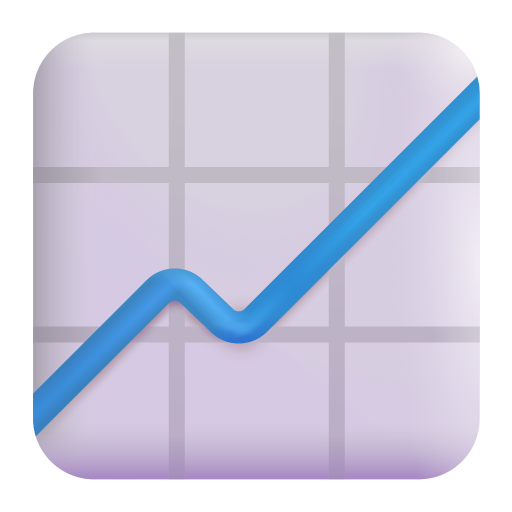Think about how often you shop online, find the perfect product, and get ready to buy only to discover it’s out of stock. Frustrating, right? Now ask yourself: how often do you actually remember to come back later and check if it’s available again? According to Shopify reports, only around 15–25% of customers return to manually check on a product they were previously interested in. That means most sales are lost simply because there’s no reminder in place.
The verdict? Don’t rely on your customers to remember. Instead, give them an easy way to stay informed by implementing Back in Stock Notifications on your website. These automated alerts allow customers to subscribe with just one click. The moment the product is available again, they get notified via email or SMS, bringing them right back to complete their purchase.
What is a Back in Stock Alert? Meaning, Use Cases & Strategy
A Back in Stock alert is a notification that lets customers know when an out-of-stock product becomes available again. Brands use these alerts to reconnect with shoppers who showed interest in a product but couldn’t complete the purchase due to inventory shortages. These alerts are typically sent via email, SMS, or push notifications.
Back in stock notifications play a critical role in reducing lost sales, especially during high-demand periods, product drops, or seasonal spikes when inventory can sell out quickly. Without a reminder, most customers simply move on to a competitor or forget about the product altogether.
By offering customers an easy way to subscribe for restock updates, you give them a reason to come back, turning missed opportunities into completed sales.
For example, even platforms like Amazon offer a “Notify me when available” option when products are out of stock. It’s a simple yet effective strategy used by top eCommerce brands.
But Back in Stock alerts aren’t just about restock notifications. Forward-thinking brands use them strategically to:
- Send alternative product recommendations in case the item takes longer to restock.
- Include special offers or discounts with the alert to reignite purchase intent.
- Build anticipation and urgency, nudging customers to act quickly before the product sells out again.
In this article, we’ll explore how smart brands implement Back in Stock strategies — not just to recover lost revenue, but to increase conversions, customer engagement, and loyalty.
Top Benefits of Notifying Customers When Products Are Back in Stock
1. Foster Brand Loyalty
When customers encounter out-of-stock products, they might seek alternatives elsewhere. By proactively notifying them when their desired items are restocked, you demonstrate attentiveness and commitment to their needs, fostering trust and encouraging repeat business. Some brands enhance this goodwill by offering exclusive discounts with these notifications.
2. Recover Lost Sales
Customers who have shown interest in a product, especially those who added it to their cart, are prime candidates for conversion. YouGov survey states that 65% of online shoppers have experienced out-of-stock issues in the past 12 months. Stockouts can disrupt this process, leading to potential sales losses. Implementing back-in-stock notifications re-engages these interested customers, providing a direct path to complete their purchase once the item is available again. This strategy effectively reduces sales drop-offs.
3. Enhance Customer Experience
Unexpected stockouts, particularly during high-demand periods or trending events, can frustrate customers. Offering back-in-stock notifications alleviates this frustration by keeping customers informed and engaged, thereby enhancing their overall shopping experience.
By implementing back-in-stock notifications, e-commerce brands can strengthen customer relationships, recover potential revenue, and provide a seamless shopping experience. Let’s explore some examples of back-in-stock notifications that will help you learn how to implement them in your specific case.
Top 10 Back in Stock Email Notification Examples to Boost Conversions
Back in stock email notifications shouldn’t just inform customers that an item is available again—they should drive immediate action using smart tactics. Brands that emphasize urgency, scarcity, and seamless purchasing see the highest conversion rates.
Let’s explore real-world examples of back-in-stock emails from top ecommerce brands that successfully re-engage customers and recover lost sales.
1. FarmFresh’s Back in Stock AMP Email – Interactive & Instant Checkout
FarmFresh takes back in stock emails to the next level by using AMP-powered interactive emails (by Netcore). Instead of just notifying customers, the email allows them to purchase the item directly within the email—reducing friction and preventing drop-offs caused by switching platforms.
Why it works:
- Eliminates extra steps in the checkout process.
- Increases conversion rates with interactive elements.
- Provides a seamless shopping experience.
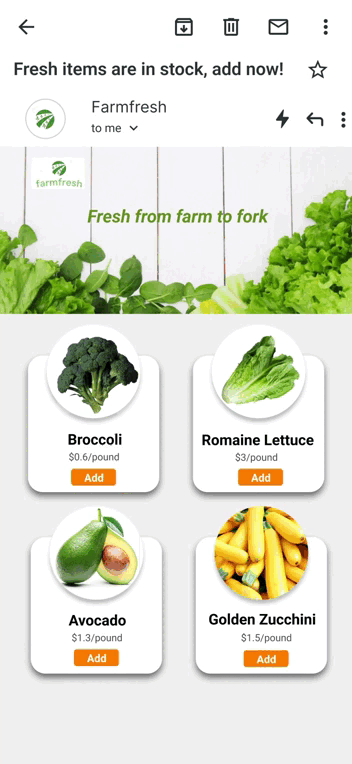
Displaying example of back in stock AMP Email by Netcore from FarmFresh
2. The Body Shop’s Personalized Back in Stock Email
When a subscriber signs up for restock alerts, they expect to see the exact item they were waiting for—and The Body Shop does this well. Their email highlights the specific product the customer requested, keeping it relevant and personalized.
Why it works:
- Focuses on the customer’s original intent.
- Uses a clear call-to-action (CTA) like “Get it before it’s gone!”
- Creates urgency by highlighting limited stock availability.
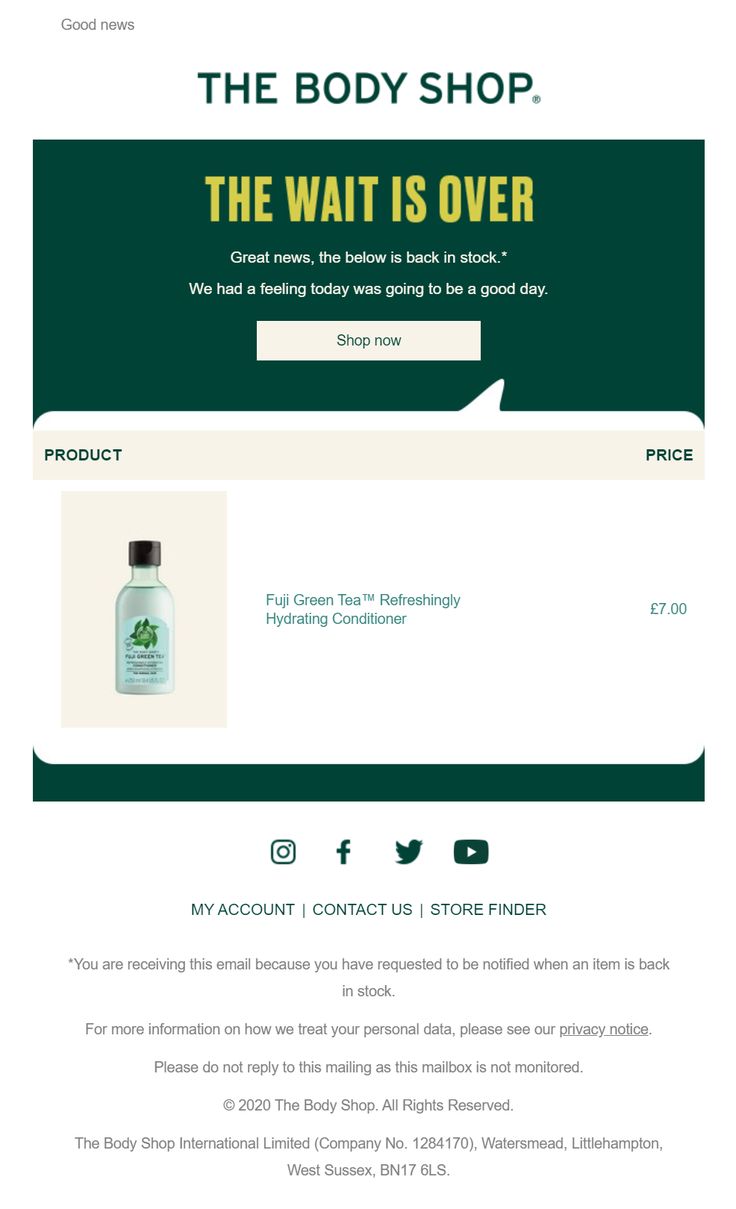
Source: https://in.pinterest.com/frelevance/
Displaying an example of back in stock Email from the Body Shop
3. Myntra’s Simple Yet Effective Restock Email
Myntra, a prominent fashion e-commerce brand, favors a simple, direct style in their back-in-stock emails. Their design is uncluttered, with a focus on the product image, price, and a prominent call to action (CTA).
Why it works:
- Straightforward messaging—no distractions.
- Minimalist design that puts focus on the product.
- Uses scarcity triggers like “Limited stock available”
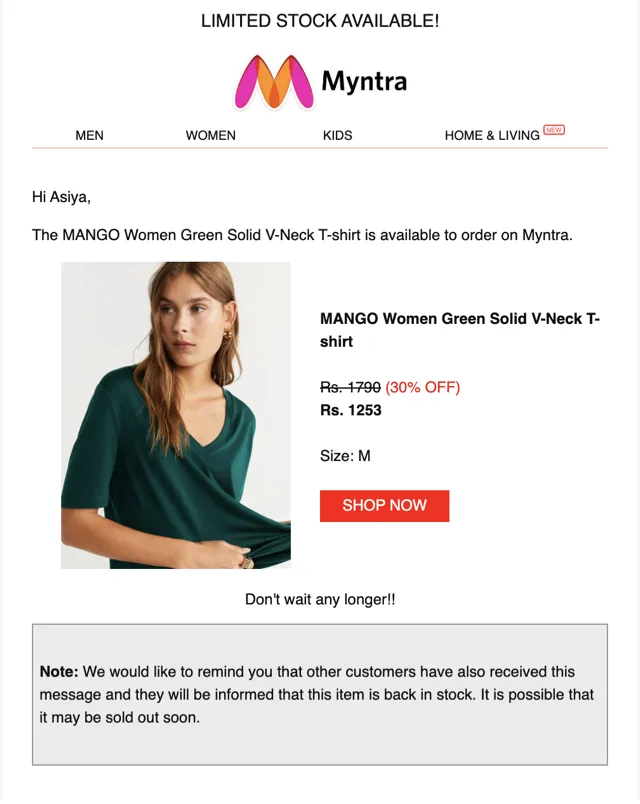
Source: Appikon
Example of back-in-stock Email from Myntra using Netcore AI-powered email delivery platform.
4. Reebok’s Engaging & Visual Back in Stock Email
Reebok uses a combination of striking visuals, customer testimonials, and a sense of exclusivity in its restock emails. They also include a social proof element by showcasing reviews to build trust and encourage purchases.
Why it works:
- High-quality visuals create an aspirational shopping experience.
- They personalize the message, for example, saying ‘Get back to heavy lifting‘ for workout shoes, directly addressing the customer’s fitness goals.

Source: Mailcharts
Example of back-in-stock Email from Reebok.
5. Nike’s VIP-Style Back in Stock Email
Nike makes restocking emails feel exclusive, targeting loyal customers with special early access before the general public. Their emails often include “Members Get First Access” messaging, making customers feel valued.
Why it works:
- Creates exclusivity to boost engagement.
- Appeals to brand loyalty and members-only perks.
- Uses a bold CTA: “Secure Your Pair Now”.
6. SpaceNK’s Email with Personalized Recommendations
Instead of just alerting customers about a restock, SpaceNK also recommends bestsellers or products based on the user’s browsing history.
Why it works:
- Increases average order value (AOV) with upselling.
- Reduces lost opportunities if the customer no longer wants the item.
- Personalization enhances customer engagement.

Source: Fresh Relevance
Example of back-in-stock Email from SpaceNK’s Email with Personalized Recommendations.
7. Walmart’s Minimalist Yet Effective Back in Stock Email
Walmart’s emails are clean, simple, and highly product-focused. They use minimal text, a product image, and a direct image CTA that prioritizes action.
Why it works:
- No unnecessary distractions pure focus on the product.
- Encourages immediate action with a “Shop Now” button.
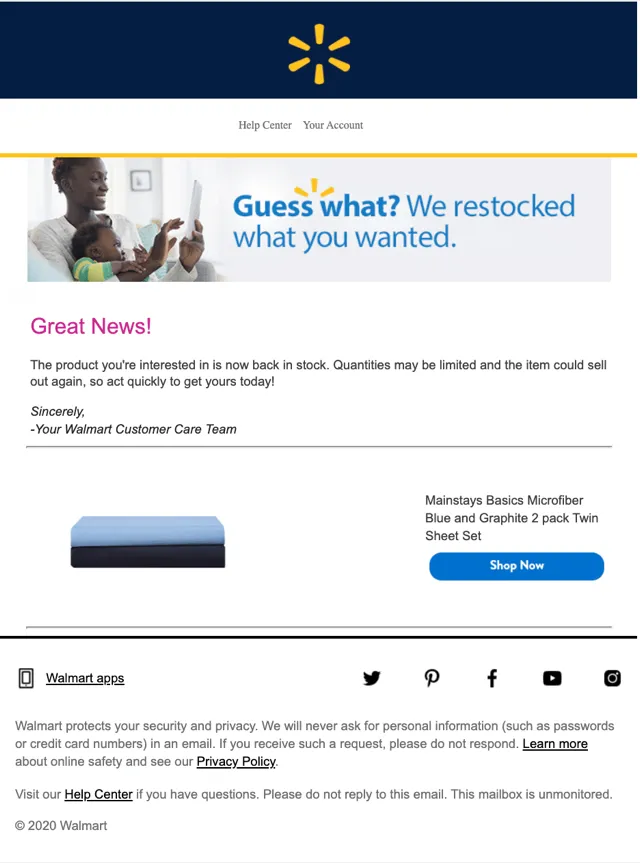
Source: Appikon
Example of back-in-stock Email from Walmart.
8. Lights4fun’s “Favorites Back in Stock” Email
Lights4fun uses “Favorites Back in Stock” messaging to recapture customer interest. Instead of a simple “Back in Stock,” they emphasize “Favorites Back in Stock” alongside the product image, and create a sense of urgency with the phrase, “We can’t guarantee they’ll be around for long.” They also strategically incorporate upsell opportunities by including a “Top Sellers” section and “Get the Complete Look” recommendations.
Why it works:
- Creates urgency: The phrase “We can’t guarantee they’ll be around for long” encourages immediate action.
- Drives website engagement: The “Top Sellers” and “Get the Complete Look” sections motivate customers to explore the website further.

Source: Appikon
Example of back-in-stock Email from Lights4fun.
Top 4 Back in Stock Push Notification Examples That Drive Sales
1. Personalized Product Alerts
Why It Works:
- Personalization: Addressing the customer by name and mentioning the specific product creates a tailored experience.
- Urgency: Encourages prompt action to avoid missing out again.

Displaying an example of a push notification with personalized product alerts.
2. Back in Stock for Wishlist Items
Why It Works:
- Personal Relevance: Notifying customers about wishlist items ensures high interest and likelihood of purchase.

Example of AJIO’s back-in-stock notification with a short-time offer.
3. Time-Sensitive Offers
Why It Works:
- Limited-Time Discount: Combining restock information with a short-term offer creates urgency and adds value.

Example of AJIO’s back-in-stock notification with a short-time offer.
4. Visual Appeal with Images
Why It Works:
- Visual Engagement: Including images makes the notification more eye-catching and informative.
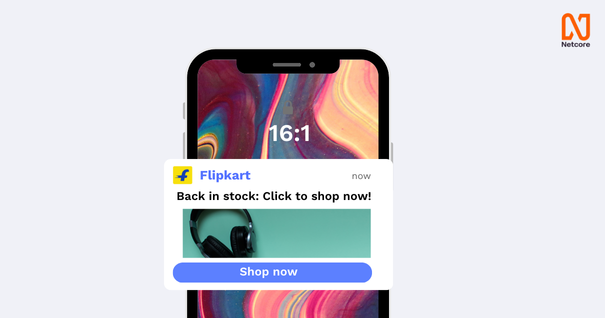
Example of Flipkart’s back-in-stock notification with an attractive visual cue.
Final Takeaway: Make Back in Stock Notifications Work for You
A well-crafted back in stock notification campaign can recover lost sales, boost conversions, and create brand loyalty. To maximize effectiveness:
- Emphasize urgency & scarcity (“Hurry! Limited stock available”)
- Make checkout seamless (AMP emails, direct purchase links)
- Use personalization (Remind customers of what they want)
- Incorporate social proof (Customer reviews, testimonials)
- Offer exclusive incentives (Free delivery, Loyalty discounts, early access)
Ready to implement these strategies and build a winning customer retention campaign for 2025? Join forces with Netcore’s Customer Success Managers. Book a personalized consultation today and discover how we can help you turn stockouts into opportunities!
 Holiday Sales Are Won Now — Grab the 2025 Holiday Marketing Guide to Unlock More Revenue.
Holiday Sales Are Won Now — Grab the 2025 Holiday Marketing Guide to Unlock More Revenue. 
